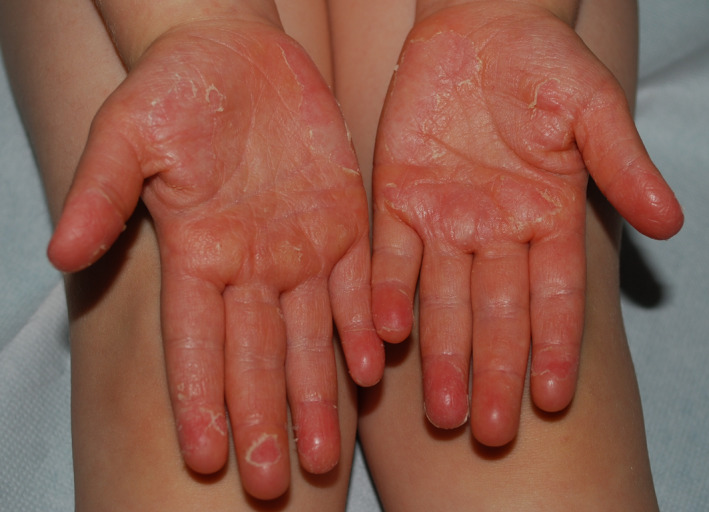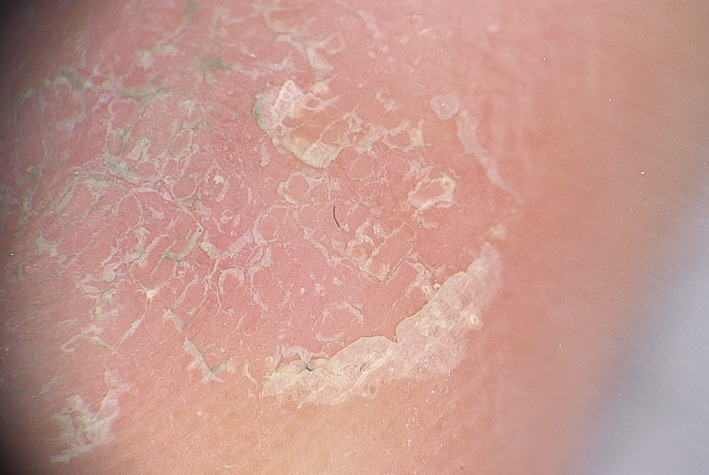Editor,
Chilblain‐like 1 , 2 , 3 and erythema multilforme‐like 4 lesions represent the most reported and studied acral skin eruptions occurring in the paediatric age during the SARS‐CoV‐2 pandemic. In the same period, we observed a peculiar acral eruption in paediatric patients. Five children (4 females and 1 male) aged from 1 to 4 years (mean age: 3 years) presented erythema and oedema involving the palmar (5/5 cases) and plantar (3/5) surfaces. The most affected sites were thenar and hypothenar areas, and the fingertips. After some days, an intense superficial desquamation with a centrifugal pattern of expansion occurred (Fig. 1). The symptoms referred were itching (5/5), pain (1/5) and burning sensation (1/5). In 2/5 cases, fever (38‐39°C) preceded the acral eruption, while a diffuse maculopapular rash occurred in 2/5 patients. The parents referred a history of warm extremities in all the cases. After 3‐4 weeks, a complete and spontaneous remission was achieved by all the patients. Dermoscopy revealed a thin peripheral whitish scale collarette, surrounding a pink structureless centre (Fig. 2).
Figure 1.

Symmetrical redness of the palms and the fingertips, with multiple round areas of superficial desquamation.
Figure 2.

The dermoscopy showed large collarette of whitish scales attached at the periphery over a pinkish unstructured background. (20 X).
All the patients underwent complete blood tests that turned out to be normal, except for a slight increase of IL‐6 titre in 2/5 patients (ranging 6.2‐8.2 pg/mL; n.r.: <5.9 pg/mL). Throat cultures for group A beta‐haemolytic streptococci (GABHS) were negative in all patients. Nasopharyngeal swab for SARS‐CoV‐2 RNA RT‐PCR, and serum SARS‐CoV‐2 IgM and IgG (CLIA; YHLO BIOTECH, Shenzhen, China) were negative. Parvovirus B19 DNA and enterovirus RNA serum PCR turned out to be negative. Serology for mycoplasma pneumoniae, Epstein–Barr virus (EBV) and cytomegalovirus (CMV) was unremarkable, except for one (1/5) patient with an acute EBV infection. Interestingly, the EBV infection was asymptomatic, without fever or sore throat. Serological test for SARS‐CoV‐2 IgM and IgG was repeated after at least three weeks confirming the negative results.
Personal and dermatological past histories were unremarkable. Indeed, family histories were positive for atopy (4/5 patients), chilblain (1/5), dyshidrosis (1/5) and hyperhidrosis (1/5).
SARS‐CoV‐2 infection was excluded, and due to the occurrence during the lockdown, other diagnosis was considered, such as hand irritant contact dermatitis (ICD) 5 and acral frictional dermatosis (AFD) 6 . ICD may represent a consequence of an intense hands' hygiene and usually manifests over the dorsum of metacarpophalangeal joints and web spaces, where the irritants and allergens accumulate 5 . Regarding our patients, two of them (2/5) referred frequent handwashing. However, hands' dorsum or web spaces were spared and palmar and plantar surfaces represented the only affected sites. AFD is a hyperkeratotic acquired dermatosis typically observed on the bony prominences of the feet and legs 6 . In our patients, this diagnosis has been excluded for the acute onset, the exclusive involvement of palms and soles, and the absence of hyperkeratosis.
Juvenile gloves and socks papular purpuric syndrome (JGSPPS) is a self‐limiting acral dermatosis characterized by purpuric and erythematous‐oedematous plaques, with subsequent petechiae development. JGSPPS might be induced by several infectious agents, including CMV, EBV and parvovirus B19 7 . In our patients, this diagnosis was excluded by serological tests, and clinically by the absence of purpuric lesions and the presence of the desquamation. The negative GABHS throat cultures allowed us to exclude post scarlet fever desquamation.
Finally, exfoliative diseases have been considered, in particular keratolysis exfoliativa (KE). KE is an under‐diagnosed palmoplantar peeling dermatosis, characterized by cyclic and recurrent superficial exfoliation and collarette desquamation, due to cleavage within the stratum corneum. The sites affected are palms, soles and fingers. Subjective symptoms are represented by pruritus, pain and burning sensation 8 . Skin biopsy was not performed in our cases; however, the clinical presentation and the dermoscopic findings were consistent with superficial peeling. We hypothesized that KE diagnosis is likely. The frequent handwashing and the stress due to the changes in lifestyle in young children might represent the triggering factors in constitutionally predisposed subjects 9 . The major limitation of our study was the small sample size and the absence of histologic confirmation. The observation of further cases would be needed to support our hypothesis.
Funding source
None.
Conflict of interest
Dr. Neri has nothing to disclose. Dr. Patrizi has nothing to disclose. Dr. Gabrielli has nothing to disclose. Dr. Virdi has nothing to disclose. Dr. Veronesi has nothing to disclose. Dr. Corsini has nothing to disclose. Dr. Lazzarotto has nothing to disclose. Dr. Lanari has nothing to disclose. Dr. Misciali has nothing to disclose. Dr. Guglielmo has nothing to disclose.
References
- 1. Neri I, Virdi A, Corsini I et al. Major cluster of paediatric 'true' primary chilblains during the COVID‐19 pandemic: a consequence of lifestyle changes due to lockdown. J Eur Acad Dermatol Venereol 2020; Online ahead of print. 10.1111/jdv.16751. [DOI] [PMC free article] [PubMed] [Google Scholar]
- 2. Piccolo V, Neri I, Filippeschi C et al. Chilblain‐like lesions during COVID‐19 epidemic: a preliminary study on 63 patients. J Eur Acad Dermatol Venereol 2020; 34: e291–e293. 10.1111/jdv.16526 [DOI] [PMC free article] [PubMed] [Google Scholar]
- 3. Docampo‐Simón A, Sánchez‐Pujol MJ, Juan‐Carpena G et al. Are chilblain‐like acral skin lesions really indicative of COVID‐19? A prospective study and literature review. J Eur Acad Dermatol Venereol 2020; Online ahead of print. doi: 10.1111/jdv.16665. [DOI] [PMC free article] [PubMed] [Google Scholar]
- 4. Torrelo A, Andina D, Santonja C et al. Erythema multiforme‐like lesions in children and COVID‐19. Pediatr Dermatol 2020; 37: 442–446. [DOI] [PMC free article] [PubMed] [Google Scholar]
- 5. Beiu C, Mihai M, Popa L, Cima L, Popescu MN. Frequent hand washing for COVID‐19 prevention can cause hand dermatitis: management tips. Cureus 2020; 12: e7506. 10.7759/cureus.7506. [DOI] [PMC free article] [PubMed] [Google Scholar]
- 6. Bodak N, Chiaverini C, Barbarot S. COVID‐19 Lockdown induced acral dermatosis in children. J Eur Acad Dermatol Venereol 2020; Online ahead of print. 10.1111/jdv.16797. [DOI] [PMC free article] [PubMed] [Google Scholar]
- 7. Hsieh MY, Huang PH. The juvenile variant of papular‐purpuric gloves and socks syndrome and its association with viral infections. Br J Dermatol 2004; 151: 201–206. [DOI] [PubMed] [Google Scholar]
- 8. Chang YY, Van der Velden J, Van der Wier G et al. Keratolysis exfoliativa (dyshidrosis lamellosa sicca): a distinct peeling entity. Br J Dermatol 2012; 167: 1076–1084. [DOI] [PubMed] [Google Scholar]
- 9. Garcovich S, Bersani FS, Chiricozzi A, De Simone C. Mass quarantine measures in the time of COVID‐19 pandemic: psychosocial implications for chronic skin conditions and a call for qualitative studies. J Eur Acad Dermatol Venereol 2020; 34: e293–e294. 10.1111/jdv.16535. [DOI] [PMC free article] [PubMed] [Google Scholar]
Acknowledgement
The patients in this manuscript have given written informed consent to the publication of their case details.


